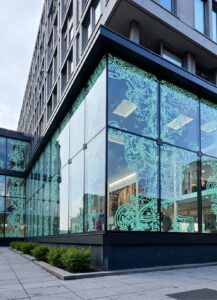Electrochromic Smart Glass Engineering
This script discusses electrochromic glass, a type of smart glass that can change its light transmission properties with the application of electrical voltage. Reneesh presents on the technology’s features, including its layers, conductive coating, and chemical reactions. The presentation differentiates between passive and active smart glass, focusing on electrochromic and polymer dispersed types. It touches on major manufacturers like Sage Glass and View Inc., highlighting their market presence and challenges such as cost and integration with other systems. Case studies, including implementations at DFW Airport and a National Geographic project, are examined to demonstrate the glass’s energy efficiency and visual functionalities. Potential hazards like electrical hazards in curtain wall systems are also discussed.
The Future of Electrochromic Smart Glass: A Dive into Engineering and Design
Introduction
In the ever-evolving landscape of architectural innovation, electrochromic smart glass stands out as a groundbreaking technology redefining how we think about energy efficiency, aesthetics, and functionality in building design. In this blog post, we’ll explore the intricacies of electrochromic glass, its applications, and the promising future it holds for architecture and engineering.
What is Electrochromic Smart Glass?
Electrochromic glass, often referred to as smart glass, is a type of glass that can change its light transmission properties when an electrical voltage is applied. It is designed for a variety of applications, including energy control, visual communication, and even decorative purposes.
Reneesh, an expert in the field, highlights that electrochromic glass functions by using a thin film that undergoes reversible chemical reactions. This reaction alters the appearance of the glass, enabling it to transition between being completely transparent or opaque. Unlike passive smart glass, which remains fixed in its properties, electrochromic glass offers dynamic modulation, providing users with more control over light and heat entering a space.
Engineering and Chemistry Behind the Technology
The engineering behind electrochromic glass is as fascinating as its application. It consists of multiple layers, including a transparent conductive coating made of indium tin oxide, which conducts electricity while still allowing light to pass through. This configuration is crucial for the thin layer of electrochromic material that changes color as ions move in or out.
Reneesh explains the importance of integrating the glass into Insulating Glass Units (IGUs) and employing robust edging techniques to preserve its functionality and minimize degradation. Moreover, manufacturers such as Sage Glass and Gauzy have paved the way, even when faced with industry challenges like bankruptcy and acquisitions.
Case Studies and Industry Impact
A notable case study involves the use of electrochromic glass at the Dallas/Fort Worth International Airport. The glass reduced surface temperatures by 15 degrees compared to traditional glass, demonstrating its potential in energy efficiency and creating more comfortable spaces—leading to increased commercial activities like dining.
Electrochromic glass’s versatility extends beyond energy savings. As Kyle notes, these systems can sometimes face challenges due to the conductive nature of materials like aluminum, which can pose risks if not properly managed. Proper maintenance and protective measures are crucial to avoiding these pitfalls.
Despite the challenges, the future of electrochromic smart glass is promising. Companies such as Bellwether Northface have utilized the technology for visual transmission on their buildings, illustrating its potential for artistic and functional integration.
Conclusion
Electrochromic smart glass is shaping the future of building design with its smart, adaptive nature. From enhancing energy efficiency to offering customizable aesthetics, this technology offers architects and engineers a valuable tool in their pursuit of more sustainable and interactive environments. As the technology evolves, we can expect even more innovative applications, driving the industry forward.
Stay tuned as developments in this field continue to illuminate the path toward smarter, more responsive building solutions.
Exploring the Future: Electrochromic Glass Technology
🔹 Technology & Functionality Keywords
-
Electrochromic Glass
-
Switchable Glass
-
Privacy Glass
-
Tint-on-Demand
-
Dynamic Glazing
-
Light Control Glass
-
Electronically Dimmable Glass
-
Smart Film Technology
-
PDLC (Polymer Dispersed Liquid Crystal)
-
SPD (Suspended Particle Device)
🔹 Benefit-Driven Keywords
-
Energy-Efficient Glazing
-
Daylight Optimization
-
Glare Reduction
-
Privacy on Demand
-
Thermal Comfort
-
UV Protection Glass
-
Solar Control Glass
-
Intelligent Building Materials
-
Green Building Solutions
-
LEED-Certified Components
🔹 Market & Use Case Keywords
-
Architectural Smart Glass
-
Automotive Smart Windows
-
Interior Partition Glass
-
Conference Room Privacy Glass
-
Hospital Privacy Solutions
-
Retail Display Smart Glass
-
Hospitality Tech Glass
-
Transportation Glazing
-
Aerospace Smart Materials
🔹 Luxury & Innovation Keywords
-
Next-Gen Glass
-
Future-Ready Façade Technology
-
Premium Glass Innovation
-
Luxury Glass Integration
-
IoT-Integrated Glazing
-
Adaptive Smart Surface
